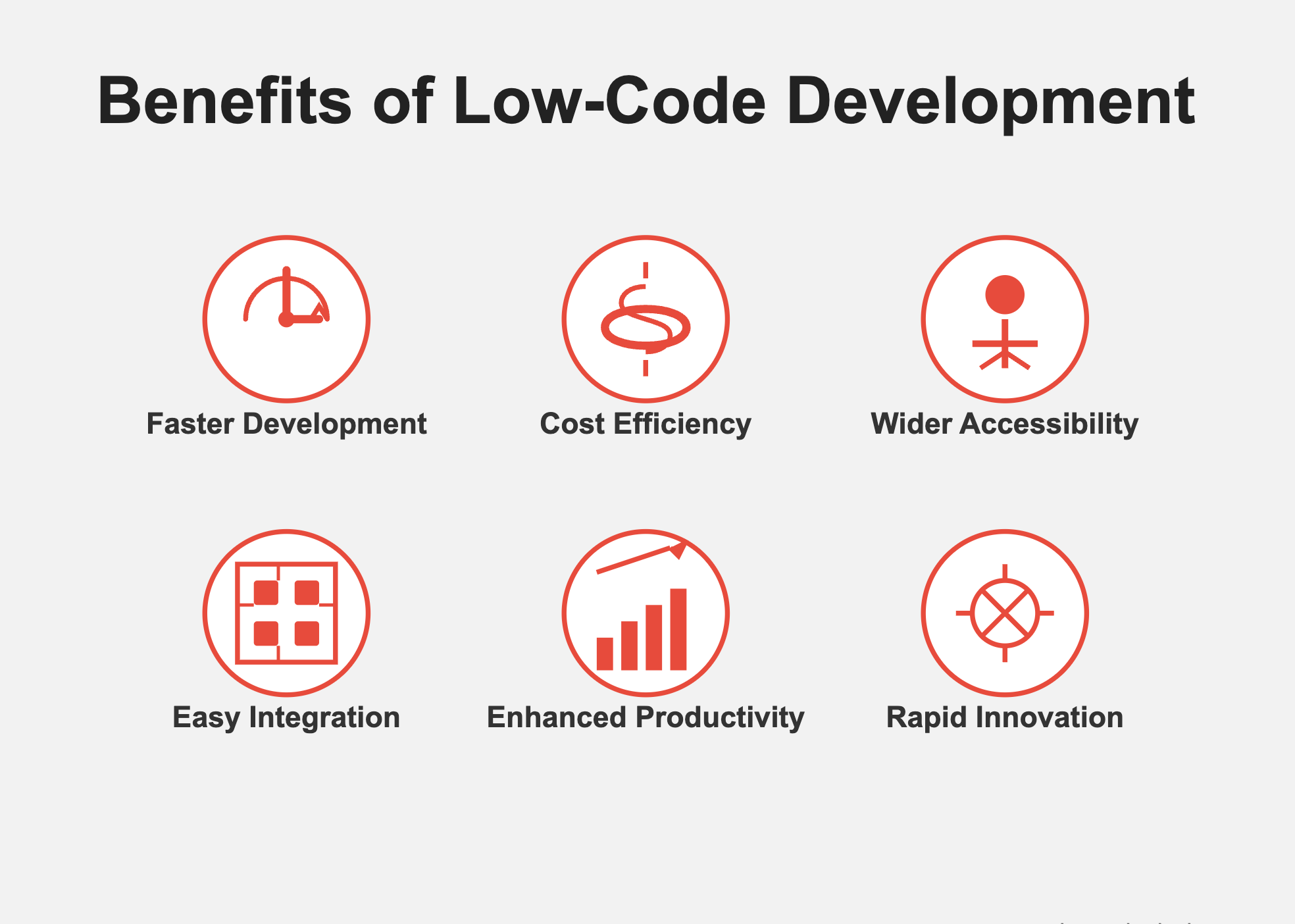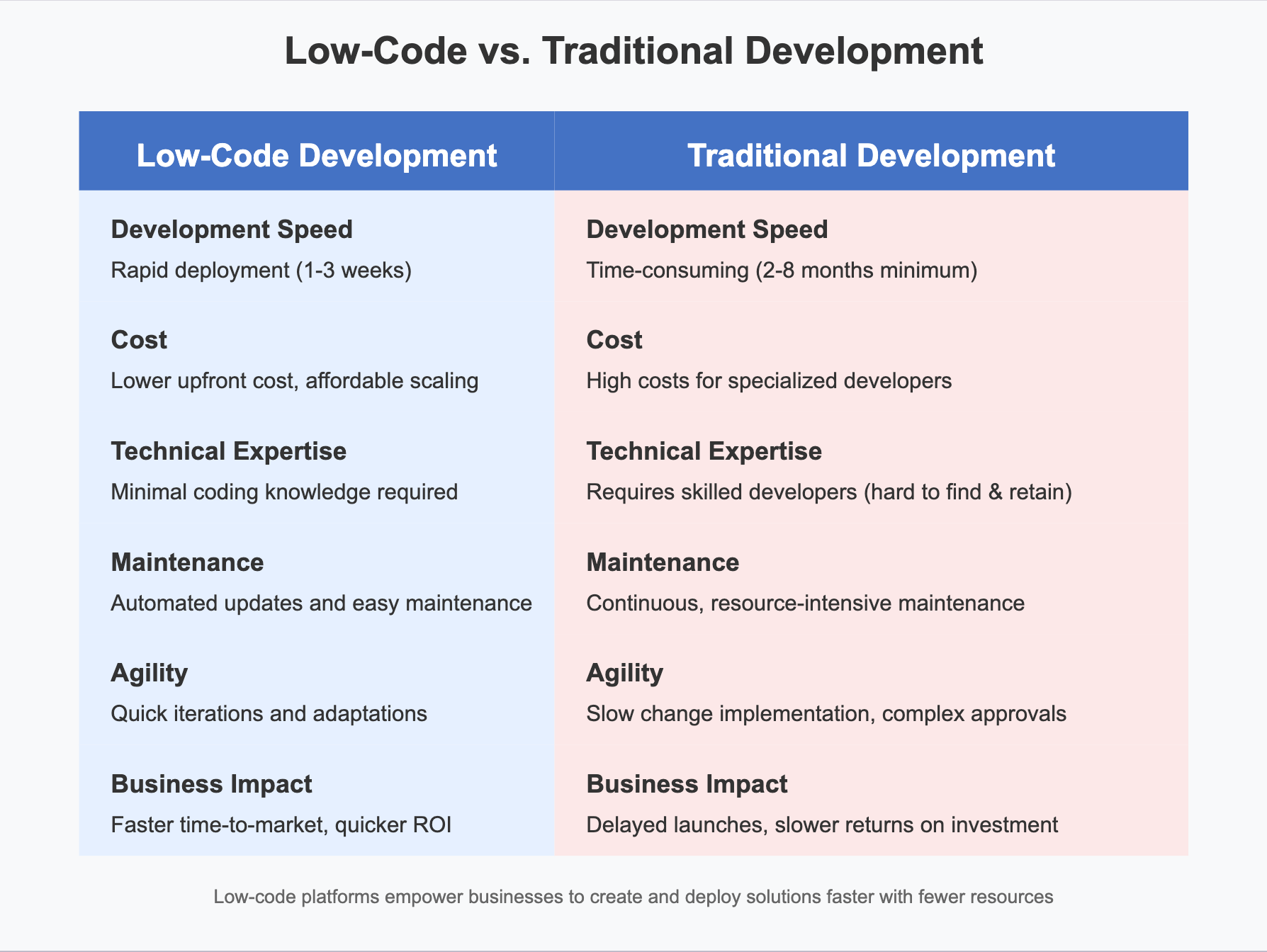

The Transformative Power of LowCode and a Comprehensive Comparison with Traditional Development
Published on April 3, 2025
Written by Jaren Hidalgo · 10 minute read
Traditional vs LowCode development: how do they stack up? In this article, we’ll compare these approaches to help you decide which is best for your project.
Key Takeaways
LowCode development platforms enable rapid application creation with minimal hand-coding, fostering innovation and collaboration between technical and non-technical team members.
The advantages of LowCode, including speed, cost-efficiency, and built-in security features, make it an attractive option for organizations aiming to enhance their development capabilities.
Combining LowCode and traditional development approaches allows businesses to leverage the strengths of both methods, producing high-quality, flexible solutions that meet diverse needs.
Understanding Traditional Development

Traditional software development, also known as hand-coding, involves writing code from scratch. This method requires a deep understanding of programming languages and a structured approach to the development process. It is a meticulous process that often involves extensive planning, coding, testing, and maintenance.
Development teams follow established methodologies to ensure that every aspect of the application development process is systematically addressed.
Skills Required for Traditional Coding
Traditional software development demands a high level of coding knowledge and technical expertise. Developers must possess advanced skills in specific programming languages such as Python, Java, and PHP. This extensive coding knowledge allows them to write code that is both efficient and highly customizable, catering to the unique needs of each project.
However, this approach also presents challenges. The creation of applications through manual coding requires a large team of skilled developers and significant technical resources. With an ongoing shortage of skilled developers, traditional development projects and app development often face delays and increased costs.
Despite these challenges, the ability to write code from scratch allows for the creation of highly specialized and complex applications.
Key Features of LowCode Development Platforms

LowCode development platform revolutionizes the software development process by enabling application creation with minimal hand-coding. These LowCode development platforms use visual interfaces, pre-built components, and automation to streamline the development process. A LowCode platform simplifies and accelerates the creation of functional software applications, offering substantial speed and cost savings. Additionally, LowCode platforms are becoming increasingly popular among businesses seeking to enhance their development capabilities.
The benefits of LowCode extend beyond rapid development. According to GlobeNewsWire, with the market expected to reach $187 billion by 2030, it’s clear that many organizations are recognizing the value of LowCode solutions. These platforms empower business users and developers alike, fostering collaboration and enabling the creation of sophisticated applications with responsive designs.
Drag-and-Drop Interfaces
One of the standout features of LowCode development platforms is the drag-and-drop interface. This functionality allows developers and non-technical users to quickly assemble applications by visually arranging components. The simplicity of drag-and-drop interfaces empowers business users to participate in the development process, reducing the reliance on skilled developers and speeding up the creation of applications.
Pre-Built Components
Pre-built components are another key feature of LowCode platforms. These ready-to-use modules enhance development speed by allowing teams to focus on customization rather than building components from scratch.
Pre-built components allow development teams to rapidly prototype and iterate on applications, meeting business needs efficiently.
Built-In Security Features
Security is a paramount concern in software development, and LowCode platforms address this with robust built-in security features. These platforms often include advanced encryption and role-based access control to protect sensitive data and ensure compliance.
LowCode platforms integrate security mechanisms directly into the development process, safeguarding data integrity and mitigating potential risks.
Comparing Development Processes

Comparing the development processes of LowCode and traditional development reveals clear differences in speed, collaboration, and costs. LowCode development stands out for its rapid application development capabilities, allowing organizations to deploy applications quickly and adapt to market changes. This visual approach, using pre-built components and drag-and-drop interfaces, contrasts sharply with the extensive coding knowledge required for traditional development.
Moreover, LowCode development is particularly beneficial for organizations facing tight deadlines and limited resources. LowCode platforms enable faster application deployment and reduce the need for extensive IT resources, offering significant speed and cost-efficiency advantages.
Kreante, for example, leverages LowCode development to enhance efficiency and accelerate project timelines, ensuring that applications are delivered on time and within budget.
Speed and Efficiency
The speed and efficiency of LowCode development are unmatched. Using LowCode tools, organizations can create prototypes and minimum viable products in a fraction of the time it would take with traditional coding methods. This rapid prototyping capability allows businesses to iterate quickly based on user feedback, reducing development time by up to 60% and enabling faster time-to-market.
Collaboration and Accessibility
LowCode development fosters collaboration between technical and non-technical team members, enhancing overall project responsiveness. LowCode platforms allow both professional developers and business users to contribute to the development process, breaking down traditional barriers and promoting a more inclusive approach to app creation.
This collaborative environment leads to improved operational efficiency and a greater ability to respond to market changes.
Cost Implications
The cost implications of LowCode development are another significant advantage. LowCode platforms reduce the need for extensive IT resources and enable more efficient resource allocation, helping organizations achieve substantial cost savings.
This lower overall development cost makes LowCode an attractive option for businesses looking to maximize their ROI while maintaining high-quality software solutions.
When to Choose LowCode Over Traditional Development

Choosing between LowCode and traditional development depends on the specific needs and goals of a project. LowCode development platforms are particularly beneficial for rapid prototyping and creating minimum viable products (MVPs). With faster development times and reduced resource costs, LowCode solutions offer a high return on investment (ROI) and are ideal for organizations looking to quickly bring new ideas to market.
Additionally, LowCode platforms are well-suited for business applications and workflow automation. By enabling non-technical users to create applications, these platforms streamline business processes and reduce the reliance on IT resources. Organizations of all sizes, from startups to enterprises, can benefit from the versatility and efficiency of LowCode development.
Rapid Prototyping and MVPs
LowCode development platforms are perfect for rapid prototyping and creating MVPs. Platforms like Bubble allow developers to quickly build interactive prototypes with minimal coding experience, enabling rapid user feedback and iteration. This approach accelerates the development process and helps businesses validate their ideas quickly and efficiently.
Business Applications and Automation
For business applications and automation, LowCode platforms offer a streamlined approach. These platforms enable the quick creation of tailored business applications, enhancing operational efficiency and automating workflows without extensive coding knowledge.
LowCode development tools empower citizen developers to develop applications, reducing the burden on IT departments and facilitating faster implementation of business solutions. No code development tools also contribute to this trend.
Legacy Systems Integration

Modernizing with LowCode
Legacy systems are older software or hardware systems that remain in use within an organization, often because they are integral to business operations. These systems can be challenging to update or replace due to their unique configurations and the critical functions they perform. LowCode platforms offer significant benefits when working with legacy systems by providing pre-built connectors and API integration capabilities. This enables organizations to extend the functionality of their existing systems, gradually modernizing their technology landscape without the need for disruptive replacements.
Complex Integration in Traditional Environments
Integrating with legacy systems using traditional development approaches often requires custom code and deep understanding of the legacy architecture. These integrations can be complex and fragile, creating long-term maintenance challenges. The specialized knowledge required for these integrations can also create dependencies on specific developers.
Kreante's Approach to Maximizing LowCode Benefits
At Kreante, we’ve developed a strategic framework to maximize the benefits of LowCode development. Our approach begins with a thorough strategic assessment, where we evaluate specific business needs and challenges to identify optimal scenarios for LowCode implementation. This ensures that the chosen LowCode solutions align with the organization’s goals and deliver the highest value.
Our collaborative design process involves both business users and technical developers, fostering innovative solutions that address real business challenges. Integrating diverse perspectives allows us to create user-centered applications that meet the unique needs of our clients. Additionally, we provide ongoing support to ensure that LowCode applications continue to function optimally and adapt to evolving user needs.
Strategic Assessment
The strategic assessment process at Kreante focuses on identifying specific business needs that align with LowCode capabilities. We conduct thorough evaluations to determine the best use cases for LowCode development, ensuring that our clients achieve their desired outcomes efficiently and effectively.
Collaborative Design
Our collaborative design methodology integrates feedback from both business stakeholders and technical developers to create user-centered applications. This approach promotes teamwork and leverages diverse perspectives, resulting in innovative and effective solutions.
Ongoing Support
Ongoing support is crucial for the success of LowCode development projects. At Kreante, we provide continuous support and resources to help teams effectively manage and adapt their LowCode projects after initial deployment, ensuring sustained success and adaptation.
Combining LowCode and Traditional Development

Combining LowCode and traditional development offers a versatile approach to software creation. Leveraging the strengths of each method, organizations can create high-quality, flexible applications that meet diverse requirements. This hybrid approach optimizes processes and speeds up time-to-market, ensuring that businesses can respond quickly to changing market demands.
Utilizing both LowCode and traditional methods allows teams to enhance overall project outcomes. The combination of these approaches leads to the creation of adaptable applications that better meet user needs and can evolve alongside business requirements.
Hybrid Development Strategies
Hybrid development strategies leverage the strengths of both LowCode and traditional development methods to create more effective solutions. Combining these approaches allows organizations to achieve faster time-to-market and optimize their development processes.
Enhancing Flexibility and Quality
Merging LowCode with traditional coding can produce adaptable and high-quality applications that meet specific business needs. This combination allows teams to leverage the strengths of each approach, enhancing the overall quality and flexibility of the final product.
Specific Use Cases for LowCode

Business Process Automation
LowCode platforms excel at automating business processes that previously relied on manual workflows, spreadsheets, or basic databases. These platforms make it easy to create applications that capture data, route approvals, generate notifications, and provide real-time visibility into process status.
Customer-Facing Web and Mobile Apps
Modern LowCode platforms can create sophisticated customer-facing applications with responsive designs and engaging user experiences. These tools have evolved beyond basic internal applications and now support the development of polished, professional web and mobile apps.
Reporting and Analytics Dashboards
LowCode platforms are ideal for creating reporting and analytics dashboards that visualize business data and support decision-making. Their drag and drop interfaces make it easy to design interactive dashboards, and their integration capabilities enable connections to various data sources.
Departmental and Line-of-Business Applications
For departmental needs and line-of-business applications, LowCode platforms offer the perfect balance of speed and functionality. These platforms allow departments to quickly implement solutions for their specific requirements without lengthy IT queues or expensive custom development.
Minimum Viable Products (MVPs)
When testing new business concepts or product ideas, LowCode platforms enable the rapid development of MVPs. This ability to quickly create functional prototypes allows organizations to validate ideas with real users before investing in full-scale development.
Kreante's Approach to LowCode Excellence
At Kreante, we’ve developed a unique methodology that maximizes the benefits of LowCode development while ensuring enterprise-grade quality, security, and scalability. Our approach includes strategic assessment, collaborative design, rapid development, quality assurance, and continuous improvement. By understanding your business objectives, technical requirements, and user needs, we select the most appropriate LowCode platform and approach that aligns with your goals.
Working closely with stakeholders, we design intuitive, effective solutions that address real business challenges. Leveraging our expertise in platforms like Bubble, WeWeb, Webflow, Xano, and FlutterFlow, we build applications quickly and efficiently, ensuring rigorous testing processes for reliability, performance, and security.
Finally, we provide ongoing support and enhancement services to help your applications evolve alongside your business.
Conclusion: Embracing the LowCode Advantage
The choice between traditional and LowCode development isn't about selecting one over the other—it's about finding the right approach for each specific need and challenge. LowCode development offers transformative benefits for organizations seeking to accelerate their digital initiatives, reduce development costs, and empower more people to participate in the creation of business applications.
At Kreante, we're passionate about helping organizations navigate this evolving landscape and by leveraging the right mix of LowCode power and traditional development approaches to achieve their goals and create a balanced technology strategy that delivers speed, flexibility, and innovation.
The future of software development is here, and it's being built with less code and more imagination. LowCode platforms are enabling a new era of collaborative, business-driven application development that delivers better outcomes in less time and at lower cost.
Whether you're looking to automate business processes, create customer-facing applications, or modernize legacy systems, LowCode development provides a powerful approach that aligns technology more closely with business objectives. As LowCode platforms continue to evolve, their capabilities will further expand, making them an essential part of every organization's technology strategy.
Are you ready to explore how LowCode development can transform your business applications? Contact Kreante today for a free consultation and discover the possibilities of modern application development. Don't forget to visit Kreante's blog to stay up to date with all the latest news and insights from the NoCode and LowCode universe.
Frequently Asked Questions
What is the main difference between LowCode and traditional development?
The main difference is that LowCode development utilizes visual tools and pre-built components for quicker application creation, while traditional development relies heavily on extensive manual coding. Embracing LowCode can significantly speed up your project and empower more people to contribute!
How do LowCode platforms enhance collaboration?
LowCode platforms enhance collaboration by allowing both technical and non-technical team members to actively participate in the development process, which fosters inclusiveness and teamwork. This shared involvement can lead to more creative and effective solutions.
When should a business choose LowCode over traditional development?
Choosing LowCode is a great option when you need to quickly develop business applications or integrate with existing systems, as it offers speed and cost efficiency. Embrace this approach for faster results and enhanced productivity!
What are some key features of LowCode platforms?
LowCode platforms offer an amazing way to streamline development with their drag-and-drop interfaces, pre-built components, and integrated security features, making it easier than ever to bring your ideas to life!
How does Kreante ensure the success of LowCode projects?
Kreante guarantees LowCode project success by focusing on strategic assessment, collaborative design, and rapid development, all while providing quality assurance and ongoing support tailored to your unique business needs. This approach empowers you to achieve your goals efficiently and effectively!

Accelerating Software Development with Vibe Coding and AI Tools at Kreante

Kreante: Accelerating Your AppDevelopment with Low-Code, AI, and “Vibecoding”




.png)


.svg)
